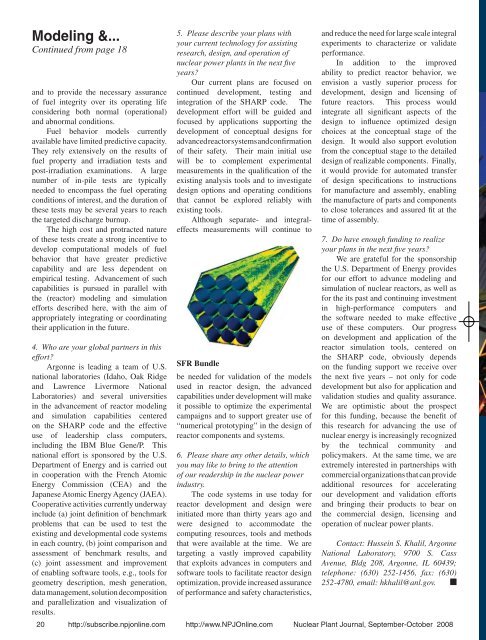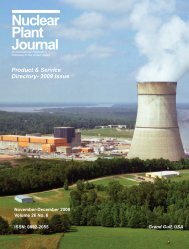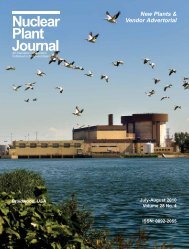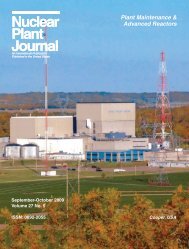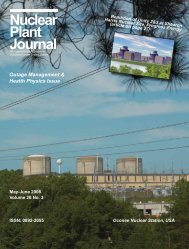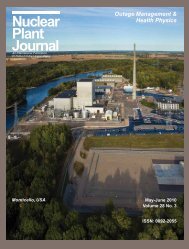Nuclear Plant Journal - Digital Versions
Nuclear Plant Journal - Digital Versions
Nuclear Plant Journal - Digital Versions
You also want an ePaper? Increase the reach of your titles
YUMPU automatically turns print PDFs into web optimized ePapers that Google loves.
Modeling &...<br />
Continued from page 18<br />
and to provide the necessary assurance<br />
of fuel integrity over its operating life<br />
considering both normal (operational)<br />
and abnormal conditions.<br />
Fuel behavior models currently<br />
available have limited predictive capacity.<br />
They rely extensively on the results of<br />
fuel property and irradiation tests and<br />
post-irradiation examinations. A large<br />
number of in-pile tests are typically<br />
needed to encompass the fuel operating<br />
conditions of interest, and the duration of<br />
these tests may be several years to reach<br />
the targeted discharge burnup.<br />
The high cost and protracted nature<br />
of these tests create a strong incentive to<br />
develop computational models of fuel<br />
behavior that have greater predictive<br />
capability and are less dependent on<br />
empirical testing. Advancement of such<br />
capabilities is pursued in parallel with<br />
the (reactor) modeling and simulation<br />
efforts described here, with the aim of<br />
appropriately integrating or coordinating<br />
their application in the future.<br />
4. Who are your global partners in this<br />
effort<br />
Argonne is leading a team of U.S.<br />
national laboratories (Idaho, Oak Ridge<br />
and Lawrence Livermore National<br />
Laboratories) and several universities<br />
in the advancement of reactor modeling<br />
and simulation capabilities centered<br />
on the SHARP code and the effective<br />
use of leadership class computers,<br />
including the IBM Blue Gene/P. This<br />
national effort is sponsored by the U.S.<br />
Department of Energy and is carried out<br />
in cooperation with the French Atomic<br />
Energy Commission (CEA) and the<br />
Japanese Atomic Energy Agency (JAEA).<br />
Cooperative activities currently underway<br />
include (a) joint definition of benchmark<br />
problems that can be used to test the<br />
existing and developmental code systems<br />
in each country, (b) joint comparison and<br />
assessment of benchmark results, and<br />
(c) joint assessment and improvement<br />
of enabling software tools, e.g., tools for<br />
geometry description, mesh generation,<br />
data management, solution decomposition<br />
and parallelization and visualization of<br />
results.<br />
5. Please describe your plans with<br />
your current technology for assisting<br />
research, design, and operation of<br />
nuclear power plants in the next fi ve<br />
years<br />
Our current plans are focused on<br />
continued development, testing and<br />
integration of the SHARP code. The<br />
development effort will be guided and<br />
focused by applications supporting the<br />
development of conceptual designs for<br />
advanced reactor systems and confirmation<br />
of their safety. Their main initial use<br />
will be to complement experimental<br />
measurements in the qualification of the<br />
existing analysis tools and to investigate<br />
design options and operating conditions<br />
that cannot be explored reliably with<br />
existing tools.<br />
Although separate- and integraleffects<br />
measurements will continue to<br />
SFR Bundle<br />
be needed for validation of the models<br />
used in reactor design, the advanced<br />
capabilities under development will make<br />
it possible to optimize the experimental<br />
campaigns and to support greater use of<br />
“numerical prototyping” in the design of<br />
reactor components and systems.<br />
6. Please share any other details, which<br />
you may like to bring to the attention<br />
of our readership in the nuclear power<br />
industry.<br />
The code systems in use today for<br />
reactor development and design were<br />
initiated more than thirty years ago and<br />
were designed to accommodate the<br />
computing resources, tools and methods<br />
that were available at the time. We are<br />
targeting a vastly improved capability<br />
that exploits advances in computers and<br />
software tools to facilitate reactor design<br />
optimization, provide increased assurance<br />
of performance and safety characteristics,<br />
and reduce the need for large scale integral<br />
experiments to characterize or validate<br />
performance.<br />
In addition to the improved<br />
ability to predict reactor behavior, we<br />
envision a vastly superior process for<br />
development, design and licensing of<br />
future reactors. This process would<br />
integrate all significant aspects of the<br />
design to influence optimized design<br />
choices at the conceptual stage of the<br />
design. It would also support evolution<br />
from the conceptual stage to the detailed<br />
design of realizable components. Finally,<br />
it would provide for automated transfer<br />
of design specifications to instructions<br />
for manufacture and assembly, enabling<br />
the manufacture of parts and components<br />
to close tolerances and assured fit at the<br />
time of assembly.<br />
7. Do have enough funding to realize<br />
your plans in the next fi ve years<br />
We are grateful for the sponsorship<br />
the U.S. Department of Energy provides<br />
for our effort to advance modeling and<br />
simulation of nuclear reactors, as well as<br />
for the its past and continuing investment<br />
in high-performance computers and<br />
the software needed to make effective<br />
use of these computers. Our progress<br />
on development and application of the<br />
reactor simulation tools, centered on<br />
the SHARP code, obviously depends<br />
on the funding support we receive over<br />
the next five years – not only for code<br />
development but also for application and<br />
validation studies and quality assurance.<br />
We are optimistic about the prospect<br />
for this funding, because the benefit of<br />
this research for advancing the use of<br />
nuclear energy is increasingly recognized<br />
by the technical community and<br />
policymakers. At the same time, we are<br />
extremely interested in partnerships with<br />
commercial organizations that can provide<br />
additional resources for accelerating<br />
our development and validation efforts<br />
and bringing their products to bear on<br />
the commercial design, licensing and<br />
operation of nuclear power plants.<br />
Contact: Hussein S. Khalil, Argonne<br />
National Laboratory, 9700 S. Cass<br />
Avenue, Bldg 208, Argonne, IL 60439;<br />
telephone: (630) 252-1456, fax: (630)<br />
252-4780, email: hkhalil@anl.gov. <br />
20 http://subscribe.npjonline.com http://www.NPJOnline.com <strong>Nuclear</strong> <strong>Plant</strong> <strong>Journal</strong>, September-October 2008


